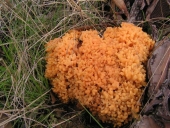
 4
4







 2
2




 2
2








Idle dreamer




Casie Becker wrote:The old rhyme is
red on black,
Good for Jack.
Red on yellow,
Kill a fellow.
I wouldn't mess with it. Thankfully, even if it is a coral snake, they are extremely nonagressive.

 1
1




Cayo Seraphim wrote:
Casie Becker wrote:The old rhyme is
red on black,
Good for Jack.
Red on yellow,
Kill a fellow.
I wouldn't mess with it. Thankfully, even if it is a coral snake, they are extremely nonagressive.
Is there a chance of finding a coral snake in a California? I just saw a snake with black red yellow and white stripes. I thought maybe it was a California mountain king snake, but I distinctly saw yellow and remembered Casie’s rhyme.




Bryant RedHawk wrote:
Yes there are coral snakes in California along the coast is where you will find them. I gathered four in Palos Verdes down on the beach in one month back in 1961, these snakes went to the LA zoo, the San Diego zoo and the museum of Natural History in San Francisco.












 3
3




List of Bryant RedHawk's Epic Soil Series Threads We love visitors, that's why we live in a secluded cabin deep in the woods. "Buzzard's Roost (Asnikiye Heca) Farm." Promoting permaculture to save our planet.




Bryant RedHawk wrote:I have not found any part of the USA that does not have some species of Rattle Snake. (Baja California to Maine)
I have captured Pacific Rattlers at the oceans edge at the Baja border all the way to Washington state, Western diamond backs in the High Sierra Nevada mountains all the way to the Grand Canyon and most of the other species of Rattle Snakes.
Most people don't find or see snakes unless they just happen upon them.
I had a friend that called me from his home in Palo Alto, he had heard a "rattler" in his garage, I got there and it was a 6 foot western diamond back, it went to the closest zoo.
















List of Bryant RedHawk's Epic Soil Series Threads We love visitors, that's why we live in a secluded cabin deep in the woods. "Buzzard's Roost (Asnikiye Heca) Farm." Promoting permaculture to save our planet.




Bryant RedHawk wrote:
(about 15 years ago I captured an Australian brown under a low deck in Sherwood Arkansas, it had a clutch of eggs which we also gathered up and they hatched two days later)
One of my friends that is a collector purchased the babies and their momma, we never found the daddy.
I've been handling snakes since the early 1960's, mostly collecting for antivenin programs.












 1
1




List of Bryant RedHawk's Epic Soil Series Threads We love visitors, that's why we live in a secluded cabin deep in the woods. "Buzzard's Roost (Asnikiye Heca) Farm." Promoting permaculture to save our planet.




Bryant RedHawk wrote:
Electric currents do nothing for snake bite treatment except that they can cause wider spreading of the venom which is the opposite of what you want.
 1
1

















 1
1




List of Bryant RedHawk's Epic Soil Series Threads We love visitors, that's why we live in a secluded cabin deep in the woods. "Buzzard's Roost (Asnikiye Heca) Farm." Promoting permaculture to save our planet.












 1
1




Cayo Seraphim wrote:
Bryant RedHawk wrote:
Electric currents do nothing for snake bite treatment except that they can cause wider spreading of the venom which is the opposite of what you want.
Redhawk, Is that based on your personal experience trying it out, or based on a review of the scientific literature.
“We previously reported that a short exposure of Crotalus atrox venom to direct electric current (dc) from a low-voltage generator, in solution, causes consistent and irreversible inactivation of venom phospholipase A(2) and metalloproteases. Here we report by in vivo assay on chicken embryos at stage 18 of development according to Hamburger and Hamilton that the hemorrhagic activity of C. atrox venom is lost after exposure to dc (from low voltage). Venom was exposed to dc ranging between 0 and 1 mA. dc values above 0.7 mA abolished hemorrhage”
List of Bryant RedHawk's Epic Soil Series Threads We love visitors, that's why we live in a secluded cabin deep in the woods. "Buzzard's Roost (Asnikiye Heca) Farm." Promoting permaculture to save our planet.

|
expectation is the root of all heartache - shakespeare. tiny ad:
Rocket Mass Heater Resources Wiki
https://permies.com/w/rmh-resources
|





